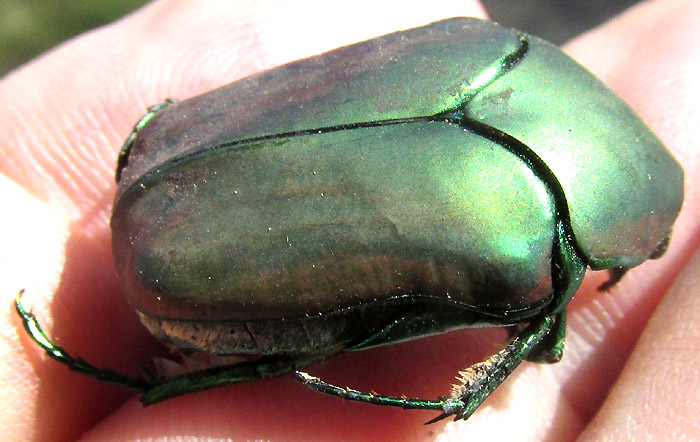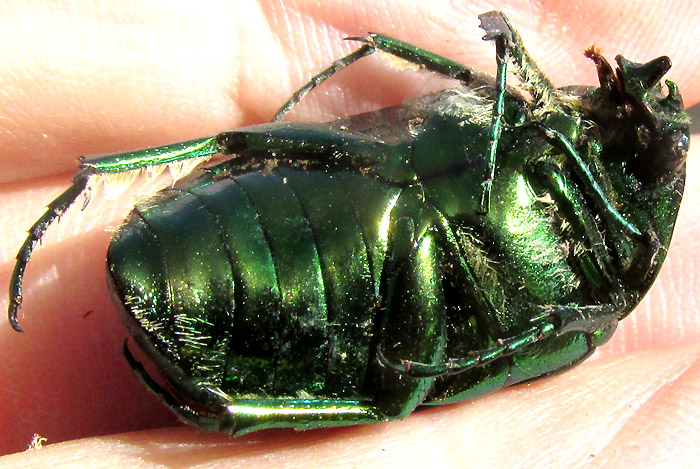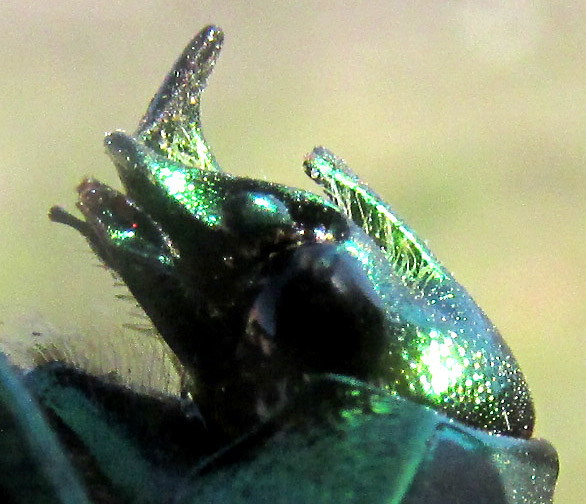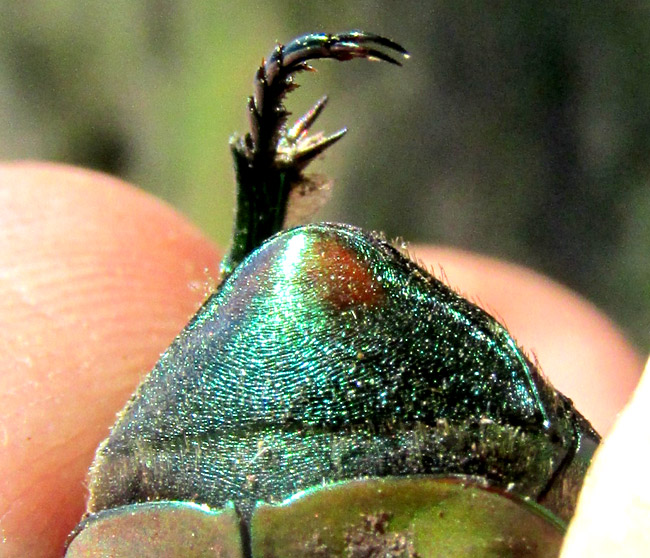Excerpts from Jim Conrad's
Naturalist Newsletter
Entry dated August 15, 2023, issued from near Tequisquiapan, elevation about 1,900m (6200 ft), Querétaro state, MÉXICO
(~N20.57°, ~W99.89°)
GREEN FIG BEETLE

Last month in this area the Smooth Mesquites dropped their prodigious yields of legumes, and some local people began gathering them and piling them into knee-high heaps around larger trees out in the scrub. Apparently the legumes were meant as livestock food, for our current long-term drought has caused poor grazing. However, some of the piles now have sat so long that their moist interiors have begun decomposing. On such a heap, the above green beetle was found, seeming to have died entering the heap. It looked like a fruit-eating Green June Beetle often seen in the US, but was it the same? What would a fruit-eater be doing digging into a pile of mesquite legumes? I needed to "do the entomology."

Above, comparing with my finger's width, you can see that this is a big beetle. Its body length was 13mm (little over 1/2 inch). Its bottom was somewhat shinier than its top, and patches of long, white hairs appeared here and there. Spurs helpful for digging occurred on the front legs' tibia bases. In the picture's top, right corner, the head bears some interesting "horns":

Such protuberances might be handy, if nothing else, for nudging aside mesquite legumes in a heap.

The broad plate forming the head's front, the clypeus -- the protuberances are hardly noticeable viewed head-on -- is flattish with a squared base, plate-like; the compound eyes are small and protected by projections of the clypeus. These features also seem well adapted for pushing forward through loose material. However, one wonders about the function of the white hairs.

The above shows the beetle's rear end, the pygidium, sticking straight up, with a stray back leg rising incongruously behind it. Later I'd learn that pygidium color, and whether it's bicolored, is a matter of discussion, and helpful in recognizing the species' many forms.
Our beetle was so similar to those in the US that I guessed that the two species belonged to the same genus, which is Cotinis. That genus is one of many kinds of scarab beetles, which often are quite colorful. The GBIF occurrences map for the genus Cotinis indicated that species of that genus commonly are observed in our semiarid upland region of central Mexico, but only one species was listed, and that was COTINIS MUTABILIS. That species is variously known as the Green Fig Beetle, Green Fruit Beetle, Figeater Beetle, and other such names.
Our Cotinis mutabilis is very closely related to and confusingly similar to the Green June Beetle, June Bug or June Beetle, Cotinis nitida, commonly occurring in the eastern US and Canada. Our beetle is considered much less damaging to gardens, though, than Green June Beetles.
A few years ago our Green Fig Beetle was restricted to Mexico and Central America, and in the US appeared only in the drier, warmer southwestern region. However, now the species is expanding its distribution eastward, especially into the southeastern states, where its grubs feed on decomposing organic matter such as that found in compost piles and organic mulch. Maybe our beetle turned up on a heap of decomposing mesquite legumes because it planned to lay eggs there, or possibly it did lay eggs, and then died.
In the semiarid souhwestern US, the adult's primary food has been cactus fruit and tree sap. However, now in the eastern US it feeds on overripe fruits in gardens and orchards, as well as soft-skinned fruits in general, such as figs, peaches, grapes, pears and tomatoes. Green Fig Beetles are described as the most widespread and highly variable species in the genus, and some experts worry that this genetic flexibility may lead to future threats to crops.
In our second-from-top picture of the upside-down beetle, the shiny, emerald color is most intense on the legs' thickest joint next to the body, the femur, and the more slender lower leg part, the tibia. The 2023 study by Michael Terlep and others entitled "Iridescent Beetle Adornments Suggest Incipient Status Competition among the Earliest Horticulturalists in Bears Ears National Monument," describes a necklace fragment composed of hollowed Cotinis mutabilis femurs strung on natural fibers, found at an archaeological site in southeastern Utah.
Since ancient times, colorful beetle body parts have been used in many cultures. The 2023 work by Cédric Finet entitled "Light as matter: natural structural colour in art," provides several pictures of iridescent-green beetle parts used as ornamentation. In one image, wings are incorporated into ornaments from a fifth century Gyeongju (Korea) tomb. In another, green beetle wings serve as the calyx of an earring looking like a flower, and in another, the more colorful undersides of green beetle bodies minus the heads are seen sowed into a headband from New Guinea. Our ancestors were enthralled by the greenish iridescence of beetle species like ours.